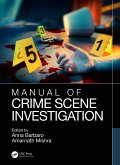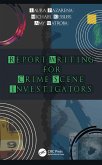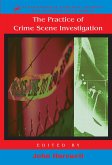David J. Doglietto (Greenfield Police Department in Monterey County
Crime Scene Processing in Correctional Facilities and Prisons
David J. Doglietto (Greenfield Police Department in Monterey County
Crime Scene Processing in Correctional Facilities and Prisons
- Broschiertes Buch
- Merkliste
- Auf die Merkliste
- Bewerten Bewerten
- Teilen
- Produkt teilen
- Produkterinnerung
- Produkterinnerung
Crime Scene Processing in Correctional Facilities is an invaluable resource for crime scene investigators, legal professionals, and the staff, leadership, and mangers of correctional facilities themselves.
Andere Kunden interessierten sich auch für
![Manual of Crime Scene Investigation Manual of Crime Scene Investigation]() Manual of Crime Scene Investigation105,99 €
Manual of Crime Scene Investigation105,99 €![Pathology of Sharp Force Trauma Pathology of Sharp Force Trauma]() Peter VanezisPathology of Sharp Force Trauma104,99 €
Peter VanezisPathology of Sharp Force Trauma104,99 €![Forensic Firearms in Criminal Trials Forensic Firearms in Criminal Trials]() J. K. Sinha (Central Forensic Laboratory, Chandigarh, India)Forensic Firearms in Criminal Trials88,99 €
J. K. Sinha (Central Forensic Laboratory, Chandigarh, India)Forensic Firearms in Criminal Trials88,99 €![Report Writing for Crime Scene Investigators Report Writing for Crime Scene Investigators]() Laura PazarenaReport Writing for Crime Scene Investigators76,99 €
Laura PazarenaReport Writing for Crime Scene Investigators76,99 €![The Practice Of Crime Scene Investigation The Practice Of Crime Scene Investigation]() John Horswell (ed.)The Practice Of Crime Scene Investigation241,99 €
John Horswell (ed.)The Practice Of Crime Scene Investigation241,99 €![The Sherlock Effect The Sherlock Effect]() Thomas W. YoungThe Sherlock Effect37,99 €
Thomas W. YoungThe Sherlock Effect37,99 €![Pathology of Sharp Force Trauma Pathology of Sharp Force Trauma]() Peter VanezisPathology of Sharp Force Trauma176,99 €
Peter VanezisPathology of Sharp Force Trauma176,99 €-
-
-
Crime Scene Processing in Correctional Facilities is an invaluable resource for crime scene investigators, legal professionals, and the staff, leadership, and mangers of correctional facilities themselves.
Produktdetails
- Produktdetails
- Verlag: Taylor & Francis Ltd
- Seitenzahl: 280
- Erscheinungstermin: 16. April 2025
- Englisch
- Abmessung: 155mm x 234mm x 18mm
- Gewicht: 496g
- ISBN-13: 9781032823140
- ISBN-10: 1032823143
- Artikelnr.: 71954153
- Herstellerkennzeichnung
- Libri GmbH
- Europaallee 1
- 36244 Bad Hersfeld
- gpsr@libri.de
- Verlag: Taylor & Francis Ltd
- Seitenzahl: 280
- Erscheinungstermin: 16. April 2025
- Englisch
- Abmessung: 155mm x 234mm x 18mm
- Gewicht: 496g
- ISBN-13: 9781032823140
- ISBN-10: 1032823143
- Artikelnr.: 71954153
- Herstellerkennzeichnung
- Libri GmbH
- Europaallee 1
- 36244 Bad Hersfeld
- gpsr@libri.de
Investigator David Doglietto, CSCSA spent 18 of his 29 years of service with the California Department of Corrections & Rehabilitation as an investigator, responsible for investigating all major crimes involving the inmate population, whether at the facility or in the community. This experience included the processing of crime scenes in this challenging environment. Now retired, he provides valuable experience and insight to teaching the scientific methodology of crime scene processing; especially in the correctional setting.
1. The Challenge 2. Selecting the Correctional Crime Scene Investigator 3.
Responsibilities 4. Crime Scene Classification System & Crime Scene
Investigation Inventory 5. Crime Scene Processing Methodology and
Checklists 6. Crime Scene Procedures & Protocol Considerations 7. The Role
of the Custodial CSI in Escapes, Use of Force, and Shooting Incidents 8.
Forensic Pathology in the Correctional Setting 9. Bloodstain Pattern
Evidence in the Correctional Setting 10. Suicide Investigations in the
Correctional Setting 11. Footwear Evidence in the Correctional Setting 12.
Fingerprint Evidence in Jails and Prison 13. Dealing with the Evidence 14.
Fire Investigations 15. Interview Techniques in the Correctional Setting
16. Essential Report Writing 17. Courtroom Testimony 18. The Conclusion
Responsibilities 4. Crime Scene Classification System & Crime Scene
Investigation Inventory 5. Crime Scene Processing Methodology and
Checklists 6. Crime Scene Procedures & Protocol Considerations 7. The Role
of the Custodial CSI in Escapes, Use of Force, and Shooting Incidents 8.
Forensic Pathology in the Correctional Setting 9. Bloodstain Pattern
Evidence in the Correctional Setting 10. Suicide Investigations in the
Correctional Setting 11. Footwear Evidence in the Correctional Setting 12.
Fingerprint Evidence in Jails and Prison 13. Dealing with the Evidence 14.
Fire Investigations 15. Interview Techniques in the Correctional Setting
16. Essential Report Writing 17. Courtroom Testimony 18. The Conclusion
1. The Challenge 2. Selecting the Correctional Crime Scene Investigator 3.
Responsibilities 4. Crime Scene Classification System & Crime Scene
Investigation Inventory 5. Crime Scene Processing Methodology and
Checklists 6. Crime Scene Procedures & Protocol Considerations 7. The Role
of the Custodial CSI in Escapes, Use of Force, and Shooting Incidents 8.
Forensic Pathology in the Correctional Setting 9. Bloodstain Pattern
Evidence in the Correctional Setting 10. Suicide Investigations in the
Correctional Setting 11. Footwear Evidence in the Correctional Setting 12.
Fingerprint Evidence in Jails and Prison 13. Dealing with the Evidence 14.
Fire Investigations 15. Interview Techniques in the Correctional Setting
16. Essential Report Writing 17. Courtroom Testimony 18. The Conclusion
Responsibilities 4. Crime Scene Classification System & Crime Scene
Investigation Inventory 5. Crime Scene Processing Methodology and
Checklists 6. Crime Scene Procedures & Protocol Considerations 7. The Role
of the Custodial CSI in Escapes, Use of Force, and Shooting Incidents 8.
Forensic Pathology in the Correctional Setting 9. Bloodstain Pattern
Evidence in the Correctional Setting 10. Suicide Investigations in the
Correctional Setting 11. Footwear Evidence in the Correctional Setting 12.
Fingerprint Evidence in Jails and Prison 13. Dealing with the Evidence 14.
Fire Investigations 15. Interview Techniques in the Correctional Setting
16. Essential Report Writing 17. Courtroom Testimony 18. The Conclusion








